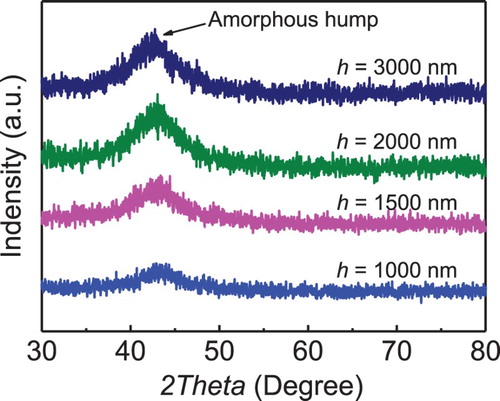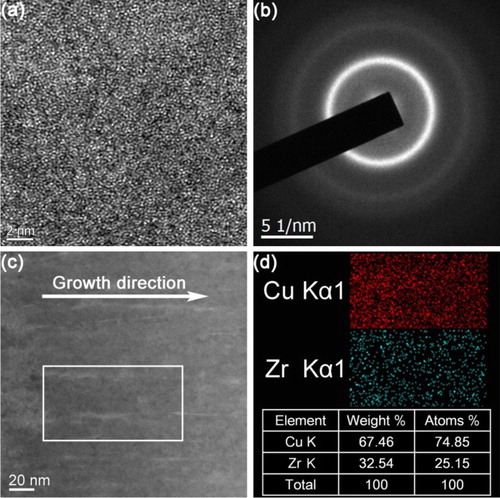ABSTRACT
The size-dependent hardness, strain-rate sensitivity (SRS) and shear transformation zone (STZ) volume of co-sputtered Cu–Zr metallic glass films with film thickness h spanning from 1000 to 3000 nm were systematically investigated by nanoindentation creep tests at room temperature. Experimental results manifested an exceptional decrease in hardness and a monotonic increment in SRS (or a monotonic decline in STZ volume) with reducing h. The deformation mechanism could be rationalized in light of more free volume combined with smaller STZs in thinner films, which likely trigger the strain-softening behavior. Moreover, STZs and deformation-induced devitrification promote the homogeneous-like plastic flow.
GRAPHICAL ABSTRACT

IMPACT STATEMENT
Employing nanoindentation creep tests revealed size-dependent hardness and strain-rate sensitivity in metallic glass films, enabling comprehensive understanding of the deformation mechanism based on atomic-scale shear transformation zone theory.
1. Introduction
Metallic glasses (MGs) alloys as a group of promising materials have been widely applied for their outstanding mechanical properties, such as the high strength, large elastic strain limit and excellent corrosion resistance [Citation1,Citation2]. However, the plastic deformation capability of MGs, especially the tensile ductility at room temperature, is very inferior which usually leads to the brittle failure [Citation3,Citation4]. Since MGs have no microstructures like dislocations and grain boundaries in ordered crystalline materials, they cannot avoid the occurrence of the highly localized shearing deformation, finally resulting in macroscopically catastrophic failure [Citation5,Citation6]. Therefore, enhancing the ductility and plastic deformability is significant for the rational design and further application of these MGs materials.
Reducing the sample size is one potential way to enable MGs to be capable of exhibiting some ductility, such as the two-dimensional film materials, which can restrict the existing shear transformation zones (STZs) from reaching a critical size to form a mature shear band (SB) [Citation7–9]. Recently, some researchers have studied the evolution of deformation morphology, microstructural characterization and mechanical properties for various MG film thicknesses. Jiang et al. [Citation9,Citation10] reported that the elastic strain limit in Ni–Nb glassy films exhibited a significant size effect, and there was a critical transformation of plastic flow from highly localized to non-localized deformation with a decrease in the film thickness during bending tests. Ghidelli et al. [Citation11] found that the fracture mode of Zr–Ni amorphous films transformed from corrugations to a perfectly flat fracture surface with a decrease in the film thickness, revealing the size effect and transition of fracture mechanism derived from the constraint on plastic dissipation. However, the investigations of time-dependent creep deformation behavior in MG thin films are quite limited [Citation12,Citation13], and the underlying deformation mechanism becomes ambiguous due to lack of long-range ordered structure, especially when the deformed volume is decreased into nanoscale [Citation2]. Currently, although atomic-scale mechanisms have been proposed to accommodate the plastic deformation of MGs, i.e. STZ [Citation14] and free volume [Citation15], their contribution to MG creep behavior is still not fully understood. Therefore, the present work aims to systematically investigate the nanoindentation creep behavior of a set of Cu–Zr MG thin films with thickness spanning from 1000 to 3000 nm using nanoindentation creep tests to reveal the size-dependent hardness and strain-rate sensitivity (SRS), and interpret it based on the free volume and STZ theory.
2. Experimental details
Monolithic Cu75Zr25 MG films were deposited on (100)-Si wafers by using direct current magnetron sputtering at room temperature. Targets of pure Cu (99.995%) and Zr (99.95%) were used to prepare the Cu–Zr films. The chamber was evacuated to a base pressure of 3.0 × 10−7 Torr, and 7.5 × 10−3 Torr of Ar was maintained during the deposition process. The Cu–Zr films with thickness h spanning from 1000 to 3000 nm were directly co-deposited on substrates. X-ray diffraction (XRD) experiments were performed on a Bruker D8 Discover powder X-ray diffractometer at room temperature. Transmission electron microscopy (TEM) and energy-dispersive X-ray (EDX) analyses were conducted on a JEOL-2100F high-resolution electron microscope.
Nanoindentation measurements were performed on all MG films deposited on Si substrates by using a TI950 TriboIndenter (Hysitron, Minneapolis) with a standard Berkovich tip at room temperature. The creep properties of the MG films were characterized under a constant loading rate , with different holding loads F of 1200, 4500 and 8000 μN, respectively. The holding time was kept for 100 s in order to obtain the quasi-static strain rate. A minimum of nine indents were performed on each specimen to obtain averages and standard deviations for hardness. The hardness after the load-holding stage is given automatically by the instrumental system software. For the Berkovich tip, the indentation strain rate
is usually expressed as [Citation16]
(1)
where l is the indentation depth and t the time. dl/dt is calculated by first fitting the l–t plot during the holding time using the empirical equation [Citation17]
(2)
where l0 and t0 are the initial values of the creep process started, and a, b and c are the fitting constants. The strain-rate sensitivity (SRS, m) is experimentally defined as the slope of the double logarithmic plot of hardness H and
under isothermal conditions, which can be expressed as
(3)
3. Results and discussion
3.1. Microstructure
High-angle XRD spectra for the as-deposited Cu–Zr MG films are displayed in Figure . The Cu–Zr films with different thickness exhibit obvious amorphous humps in the diffraction angle-range of 35°–45°, which become more apparent with increasing h, and no other crystalline peaks are observed.
The microstructure of a Cu–Zr MG film with h = 2000 nm examined in detail via high-resolution TEM (HRTEM) observations is exemplarily displayed in Figure (a). One can see the Cu–Zr film has a fully amorphous structure without any crystalline phase. The selected area diffraction pattern (SADP) also exhibits diffuse amorphous rings, as shown in Figure (b). EDX mapping analysis of the rectangle region in Figure (c,d) shows that the constituent elements (i.e. Cu and Zr) are uniformly distributed in the film, and the atom percentage of Cu and Zr are 74.85 at.% and 25.15 at.%, respectively (see Figure (d)). This is consistent with the nominal atom percentage of Cu75Zr25 calculated from the deposition rates.
3.2. Creep behavior
Figure (a,b), respectively, presents the typical load–depth curves of nanoindentation creep tests at three different holding loads of h = 1000 nm film and four different thickness films under a constant F = 4500 μN, all of which manifest smooth mechanical response without notable discrete burst of rapid displacement under the load-controlled mode. Obviously, the smaller holding load results in a shallower creep depth, while as the film thickness is decreased, the creep depth becomes larger, indicating softening behavior in the thinner films.
Figure 3. Representative load–depth curves of the Cu–Zr film with h = 1000 nm at different holding loads (a) and with different h at a constant holding load of 4500 μN (b).
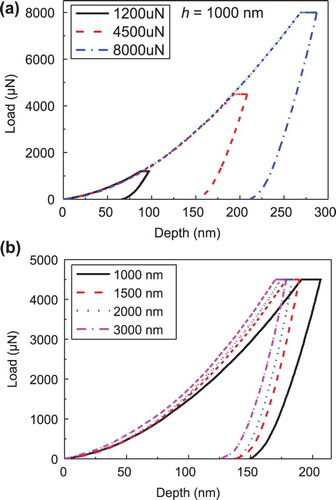
The indenter displacement vs. creep time curve at a constant indentation load during the load-holding stage can be fitted by the function in Equation (2). The experimental data and fitting curve of a representative sample (h = 2000 nm, F = 4500 μN) are shown in Figure (a). Variations in creep depth as a function of creep time during the load-holding stage with different thickness films are displayed in Figure (b), which indicates an initial rapid increase in creep depth (transient creep), followed by a stage with a lower creep rate (steady-state creep). Besides, the creep depth under a constant F increases with decreasing h, manifesting a softening behavior in thinner MG films. Figure (c) representatively shows the creep strain rate vs. creep time curves of 1500 nm thick film calculated by Equation (1) at different holding loads. For all three holding loads, the strain rate decreases towards the steady-state creep stage with prolonged holding time, but the smaller holding load approaches a higher creep rate. Figure (d) presents the variation in hardness with creep strain rate during the load-holding stage. In order to further investigate the creep mechanism of Cu–Zr MG films, the SRS m could be determined through the slope of the log (hardness)–log (strain rate) curve.
Figure 4. (a) Representative experimental results and fitting curve of h = 2000 nm Cu-Zr MG film. (b) Fitting creep responses for Cu–Zr films with different h. (c) Representative creep strain rate as a function of creep time for h = 1500 nm Cu–Zr film at different holding loads. (d) Example of the experimental method to determine the SRS.
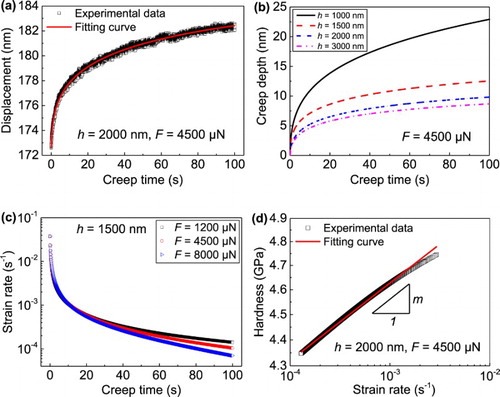
3.3. Size-dependent hardness and SRS
The experimental hardness of Cu–Zr films at three different holding loads gradually decreases with decreasing h, as shown in Figure (a), presenting apparent softening behavior. This is inverse with the general situation in nanocrystalline metals that hardness is enhanced with reducing the grain size or/and film thickness [Citation2], exhibiting obvious inverse size-dependent effect. Meanwhile, the hardness at a smaller holding load (shallower creep depth) is higher than that at a larger holding load (deeper creep depth), which is usually the result of the indentation size effects (ISE) [Citation18,Citation19]. Interestingly, the SRS m of Cu–Zr films at different holding loads calculated by Equation (3) exhibits an opposite trend compared with the variation in hardness, also showing obvious h-dependence (see Figure (b)). The m value over this h-range increased remarkably with reducing h, and decreased with raising the holding load for one given MG film.
Figure 5. Experimental results of nanoindentation hardness (a), strain-rate sensitivity m (b) and STZ volume (c) as a function of h for the Cu–Zr films at different holding loads.
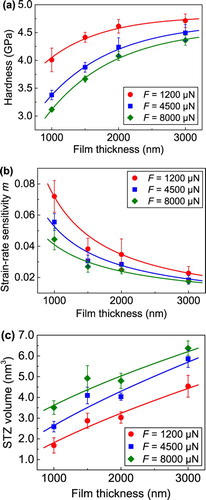
In MG materials, it has been generally accepted that the fundamental flow unit of plasticity is STZ, which is a small cluster of atoms consisting of large free volume site with immediate adjacent atoms. These atomic-scale STZs cooperatively reorganize under the applied shear stress for triggering the formation and propagation of SBs via the collective operation. According to the general flow equation that considers the shear strain rate, shear stress and free volume by Spaepen [Citation20], a relationship between hardness and free volume at a fixed strain rate can be described as
(4)
where k is the Boltzmann constant, T the absolute temperature, ϵ0 the strain of a unit flow, v0 the volume of a unit flow, β a constant, α a geometrical factor, v* the effective hard sphere size of the atom and vf the average free volume of an atom. Apparently, when the average free volume decreases, hardness will be enhanced. As Jiang et al. reported [Citation10], the thinner metallic glassy film contains more free volume or STZs due to the lower density. Therefore, more free volume or/and STZs and their cooperation will induce the dilatation of MG structure and a more viscous-like plastic deformation in the thinner Cu–Zr films, thus the mechanical softening will be more likely to occur. In addition, there exists an inhomogeneous strain field with the strong gradient in the plastic deformation zone underneath the indenter [Citation21]. The strain gradient could lead to an extra imbalance among the STZs, i.e. inhomogeneous distribution, and promote the cooperative flow of STZs (or free volume). At low holding load (shallow creep depth), the strain gradient is significantly larger than that at high holding load (high creep depth) [Citation22]. Since the volume of material involved in the deformation is smaller, the SBs created at lower holding load should be generally much smaller than that at a higher holding load. Thus, it is harder for these numerous smaller SBs to collectively produce localized deformation, whereas few larger SBs at higher holding load would result in more inhomogeneous plastic flow, subsequently inducing local structural relaxation and/or strain-softening behavior. Thus the so-called ISE happens, as confirmed through our hardness results in Figure (a).
SRS m of bulk MGs has been intensively studied in recent years, yet the value has been reported to be positive [Citation23,Citation24], negative [Citation25] or close to zero [Citation26]. This inconsistency may be related to the difference in composition, loading mode and sample geometry. However, limited literatures have been reported for the MG films. Liu et al. revealed a seemingly negative SRS in Zr-based films using displacement controlled nanoindentation, which was qualitatively interpreted by the effective strain rate-dependent degree of elastic deformation [Citation27]. In the previous study [Citation8], the size-dependent negative SRS of Cu–Zr films was measured by the method of changing nanoindentation loading rate, and explained in terms of the deformation-induced devitrification (DID) behavior. In any case, the deformation mechanism during the plastic flow is closely related to the variation of free volume in materials. Considering the DID during the nanoindentation creep tests, it would produce significant effects on the microstructure evolution and creep behavior. Since DID is a process of reduction in localized volume, the density of the amorphous region around the crystallites would decrease naturally, leading to the reduction in viscosity and the increment in free volume. Moreover, the nucleation of SBs will also promote plasticity and cause dilatation of the atomic structure (e.g. generation of free volume) in the vicinity of SBs. With the steady-state creep proceeding, more and more plastic deformation will be accumulated within the small deformed volume underneath the indenter, i.e. more sites with larger free volumes are created for shearing flow in the films, which will result in more significant dilatation of the atomic structure and decrease in viscosity. Therefore, the creep strength of films will gradually decrease with a decline in the creep strain rate, exhibiting positive SRS.
According to the conventional free volume theory [Citation15], a large SRS value indicates homogeneous plastic flow of the material. During the creep deformation, the movement of STZs will cause local dilatation of the nearby free volume, which creates localized distortions of neighboring STZs and promotes the SB initiation by either decreasing the required activation energy or rendering more possible STZs. As mentioned in the previous study [Citation8], DID becomes more intense in thinner Cu–Zr films during plastic deformation, inducing more pronounced localized dilatation. That means there will be more flow units STZs (associated with more free volumes) participating in the collective operation and generating many fine SBs in thinner films, which induces a more homogeneous-like plastic flow of the material. Subsequently, the applied strain relaxes, leading to small but rapid stress drops in the vicinity of SBs and higher SRS m values. In the most widely accepted theory of the amorphous plasticity, at low temperature or high stress, inhomogeneous plastic deformation occurs at localized sites via forming SBs. At steady-state creep, atomic diffusion may be enhanced as a result of a higher rate of dynamic equilibrium of the rearrangement of STZs [Citation12]. Thus, the fine SBs created at a low holding load due to the larger strain gradient underneath the indenter are likely to exhibit collectively a more homogeneous flow behavior with higher SRS, and vice versa at a high holding load, as shown in Figure (b).
Additionally, the activation and subsequent evolution of STZs play a significant role in the shearing events, connecting the internal flow units and external mechanical properties in MGs. Some efforts have been devoted to investigate the effect of STZ volume on the ductility of MGs [Citation28]. According to Johnson and Pan’s work [Citation28,Citation29], the STZ volume Ω in MGs can be expressed as
(5)
where
the constants R ≈ 1/4 and ζ ≈ 3.0, the average elastic strain limit γC = 0.027, τC and G0 are the threshold shear resistance and the shear modulus at temperature 0 K, respectively, τC/G0 ≈ 0.036. τCT/τC at a certain temperature T can be estimated by the equation
, Tg is the glass transition temperature of MGs (∼787 K for the Cu–Zr films) [Citation29]. Thus, the calculated STZ volume in Cu–Zr films decreases with reducing h, as shown in Figure (c). Generally, the plastic deformation of MGs is realized through the activation and cooperative shearing of STZs. A smaller STZ volume enables a more number of STZs to be activated for sustaining the plastic strain, which could enhance the atomic rearrangement and carry the homogeneous deformation. Moreover, the smaller STZs can relax or regenerate more easily, thus promoting the evolution of STZs for homogeneous-like plasticity and suppressing the internal stress concentrations at larger STZ positions in case the aggregation of STZs develops into mature SBs. In this study, the calculated STZ volume in thicker Cu–Zr films is larger than that in thinner films, implying that large STZs promote the formation of highly localized SBs and subsequent shear deformation, which is consistent with the analysis results of SRS. Certainly, STZs with a smaller size at a lower holding load are more likely to drive the homogeneous plastic deformation through generating embryonic SBs compared to that at a higher load, as discussed above, also showing the observed ISE. In a word, the activation of smaller STZs combined with more free volume in MGs would be more inclined to induce the homogeneously plastic flow rather than highly localized shear banding. Our findings provide an intrinsic insight of the relationship between flow unit and deformation behavior.
4. Conclusions
This work systematically investigated the mechanical properties of Cu–Zr metallic glass films with film thickness ranging from 1000 to 3000 nm by nanoindentation creep testing, shedding light on their size-dependent creep behavior. Experimental results demonstrated that the creep hardness of Cu–Zr films decreased with reducing h, presenting an inverse size effect. However, a positive SRS was measured that increased monotonically with decreasing h (or STZ volume decreased monotonically). The deformation mechanism is depicted by the free volume and STZ theory, indicating that more free volume combined with smaller STZs in thinner films will cause the mechanical softening behavior but a homogeneous-like plastic flow. In addition, the indentation size effect on the mechanical properties of Cu–Zr films was discussed based on the strain gradient in deformed zone underneath the indenter.
Disclosure statement
No potential conflict of interest was reported by the authors.
ORCID
Daniel Kiener http://orcid.org/0000-0003-3715-3986
Additional information
Funding
References
- Schuh C, Hufnagel T, Ramamurty U. Mechanical behavior of amorphous alloys. Acta Mater. 2007;55:4067–4109. doi: 10.1016/j.actamat.2007.01.052
- Greer JR, De Hosson JTM. Plasticity in small-sized metallic systems: intrinsic versus extrinsic size effect. Prog Mater Sci. 2011;56:654–724. doi: 10.1016/j.pmatsci.2011.01.005
- Sun BA, Wang WH. The fracture of bulk metallic glasses. Prog Mater Sci. 2015;74:211–307. doi: 10.1016/j.pmatsci.2015.05.002
- Eckert J, Das J, Pauly S, et al. Mechanical properties of bulk metallic glasses and composites. J Mater Res. 2011;22:285–301. doi: 10.1557/jmr.2007.0050
- Greer AL, Cheng YQ, Ma E. Shear bands in metallic glasses. Mater Sci Eng R. 2013;74:71–132. doi: 10.1016/j.mser.2013.04.001
- Trexler MM, Thadhani NN. Mechanical properties of bulk metallic glasses. Prog Mater Sci. 2010;55:759–839. doi: 10.1016/j.pmatsci.2010.04.002
- Lu XL, Li Y, Lu L. Co-existence of homogeneous flow and localized plastic deformation in tension of amorphous Ni–P films on ductile substrate. Acta Mater. 2016;106:182–192. doi: 10.1016/j.actamat.2016.01.001
- Wang YQ, Zhang JY, Liang XQ, et al. Size- and constituent-dependent deformation mechanisms and strain rate sensitivity in nanolaminated crystalline Cu/amorphous Cu-Zr films. Acta Mater. 2015;95:132–144. doi: 10.1016/j.actamat.2015.05.007
- Ma Y, Cao QP, Qu SX, et al. Effect of structural relaxation on plastic flow in a Ni-Nb metallic glassy film. Acta Mater. 2012;60:3667–3676. doi: 10.1016/j.actamat.2012.03.014
- Jiang QK, Liu P, Cao QP, et al. The effect of size on the elastic strain limit in Ni60Nb40 glassy films. Acta Mater. 2013;61:4689–4695. doi: 10.1016/j.actamat.2013.04.053
- Ghidelli M, Gravier S, Blandin J-J, et al. Size-dependent failure mechanisms in ZrNi thin metallic glass films. Scr Mater. 2014;89:9–12. doi: 10.1016/j.scriptamat.2014.06.011
- Cao Z, Zhang X. Nanoindentation creep of plasma-enhanced chemical vapor deposited silicon oxide thin films. Scr Mater. 2007;56:249–252. doi: 10.1016/j.scriptamat.2006.09.022
- Ma Y, Peng GJ, Debela TT, et al. Nanoindentation study on the characteristic of shear transformation zone volume in metallic glassy films. Scr Mater. 2015;108:52–55. doi: 10.1016/j.scriptamat.2015.05.043
- Argon AS. Plastic deformation in metallic glasses. Acta Metall. 1979;27:47–58. doi: 10.1016/0001-6160(79)90055-5
- Spaepen F. A microscopic mechanism for steady state inhomogeneous flow in metallic glasses. Acta Metall. 1977;25:407–415. doi: 10.1016/0001-6160(77)90232-2
- Lucas BN, Oliver WC. Indentation power-law creep of high-purity indium. Metall Mat Trans A. 1999;30:601–610. doi: 10.1007/s11661-999-0051-7
- Li H, Ngan AHW. Size effects of nanoindentation creep. J Mater Res. 2004;19:513–522. doi: 10.1557/jmr.2004.19.2.513
- Van Steenberge N, Sort J, Concustell A, et al. Dynamic softening and indentation size effect in a Zr-based bulk glass-forming alloy. Scr Mater. 2007;56:605–608. doi: 10.1016/j.scriptamat.2006.12.014
- Cao ZH, Lu HM, Meng XK, et al. Indentation size dependent plastic deformation of nanocrystalline and ultrafine grain Cu films at nanoscale. J Appl Phys. 2009;105:083521. doi: 10.1063/1.3110087
- Chou HS, Huang JC, Chang LW, et al. Structural relaxation and nanoindentation response in Zr-Cu-Ti amorphous thin films. Appl Phys Lett. 2008;93:191901. doi: 10.1063/1.2999592
- Nix WD, Gao H. Indentation size effects in crystalline materials: a law for strain gradient plasticity. J Mech Phys Solids. 1998;46:411–425. doi: 10.1016/S0022-5096(97)00086-0
- Tymiak NI, Kramer DE, Bahr DF, et al. Plastic strain and strain gradients at very small indentation depths. Acta Mater. 2001;49:1021–1034. doi: 10.1016/S1359-6454(00)00378-5
- Limbach R, Rodrigues BP, Wondraczek L. Strain-rate sensitivity of glasses. J Non-Cryst Solids. 2014;404:124–134. doi: 10.1016/j.jnoncrysol.2014.08.023
- Ma W, Kou H, Li J, et al. Effect of strain rate on compressive behavior of Ti-based bulk metallic glass at room temperature. J Alloy Compd. 2009;472:214–218. doi: 10.1016/j.jallcom.2008.04.043
- Dalla Torre FH, Dubach A, Siegrist ME, et al. Negative strain rate sensitivity in bulk metallic glass and its similarities with the dynamic strain aging effect during deformation. Appl Phys Lett. 2006;89:091918. doi: 10.1063/1.2234309
- Zhang J, Park JM, Kim DH, et al. Effect of strain rate on compressive behavior of Ti45Zr16Ni9Cu10Be20 bulk metallic glass. Mater Sci Eng A. 2007;449–451:290–294. doi: 10.1016/j.msea.2006.02.405
- Liu FX, Gao YF, Liaw PK. Rate-dependent deformation behavior of Zr-based metallic-glass coatings examined by nanoindentation. Metall Mat Trans A. 2008;39:1862–1867. doi: 10.1007/s11661-007-9399-8
- Pan D, Inoue A, Sakurai T, et al. Experimental characterization of shear transformation zones for plastic flow of bulk metallic glasses. Proc Natl Acad Sci USA. 2008;105:14769–14772. doi: 10.1073/pnas.0806051105
- Johnson W, Samwer K. A universal criterion for plastic yielding of metallic glasses with a (T/Tg)2/3 temperature dependence. Phys Rev Lett. 2005;95:195501. doi: 10.1103/PhysRevLett.95.195501

